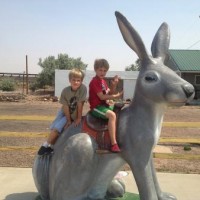Making the most of vacation memories

Route 66 runs through Winslow, Arizona. This corner is a tribute to the Eagles song, “Take it Easy.” The camera used included a date stamp. (Photo by Lynda Schmitz Fuhrig)
In the summer of 2013, my family and I took a vacation that was decades in the making. I actually consider it a once-in-a-lifetime adventure. More than 20 years ago my father and I talked about going on a Route 66 road trip, but it did not happen as life got busier with careers, moves, children, and other daily routines. We decided that it was finally time to do it – even if it meant only part of the 2,400-plus-mile road would be traveled due to time, expenses, and other constraints. The Mother Road goes from Chicago to Los Angeles (or Santa Monica Pier, depending on whom you ask).
My husband and I previously had traveled the iconic road from Chicago to St. Louis in two trips. Of course, this was before the explosion of the Internet, GPS devices, digital cameras, and apps that can make traveling easier. The road was decommissioned in 1985 and had been on the decline for decades as interstates made travel faster.
The 10-day journey comprised three generations in a borrowed family vehicle. The starting point was San Bernardino, California, taking a pass on Los Angeles this time. We went about 800 miles into Arizona and New Mexico on the route most the time (a decommissioned road means some rough spots and mysterious or missing segments). There were side trips to the Grand Canyon and El Morro National Monument in New Mexico. We were treated to beautiful landscapes, wild burros in Oatman, Arizona, iconic Route 66 signage, and lots of old roadside lodging and diner options you won’t find near the interstates. My boys even got to enjoy a movie at drive-in theater for the first time.

A road trip is not complete without a stop at a roadside diner. Breakfast is served all day at the Galaxy Diner in Flagstaff, Ariz., on Route 66. (Photo by Lynda Schmitz Fuhrig)
Not only are vacations about places but people as well. My father and I had a nice conversation with Mauricio Perez of Seligman, Arizona. The family runs a popular gift shop, and his father-in-law is Angel Delgadillo, 87, who is considered one of Route 66’s biggest supporters through his efforts to revitalize the highway after its decommissioning. We even talked about how the Delgadillo family is featured in the America on the Move exhibition at the National Museum of American History. Perez said they needed to take a trip east to Washington, D.C., to see it.
The allure of Route 66 has grown in the decades since its closing and attracts visitors from all over the world. Delgadillo, who is a barber, was giving a haircut to a filmmaker from Spain working on a Route 66 special while we were there.
Of course, we tried to document as much as we could through our cameras, resulting in lots of digital photos (there were more cameras than travelers). I did upload the images to my computer as soon as I got home and also printed the ones that I considered special for display. But a year later I still need to finish the job of deleting some of the images that I don’t need to keep and were missed during a first review (blurry ones, duplicates taken from inside the car by the youngest passengers, etc.), as well as making sure metadata is there.
There also are steps you can take before and during the trip to get the most out of the memories you are making:
- Get to know your camera/s before the trip especially if it is new. Most digital cameras have multiple options these days that you might want to use, such as a timestamp on the image. Some cameras and smartphone cameras also have GPS capability, which will note in the metadata of where the image was taken as a geotag. Take the instruction manual along if you have space for it.
- Delete blurry photos when you have down time (waiting for lunch, waiting at the airport, waiting to go on an amusement park ride, etc). Digital cameras allow us to take more pictures than with film, which can be a mixed blessing.
- Try out apps that can track your trip to create a map of the route that can be saved, if you have a tablet or smart phone.
- Write or type up observations while they are fresh in a travel journal/blog.
- Collect impressions of others who travel with you either by video or audio recording or writing them down.
- Consider purchasing some old-fashioned postcards to round out the images especially if you forgot to take some at a particular spot.
This post by digital archivist Linda Schmitz Fuhrig was originally published by the Smithsonian Institution Archives blog, The Bigger Picture.
Posted: 18 July 2014
- Categories:






